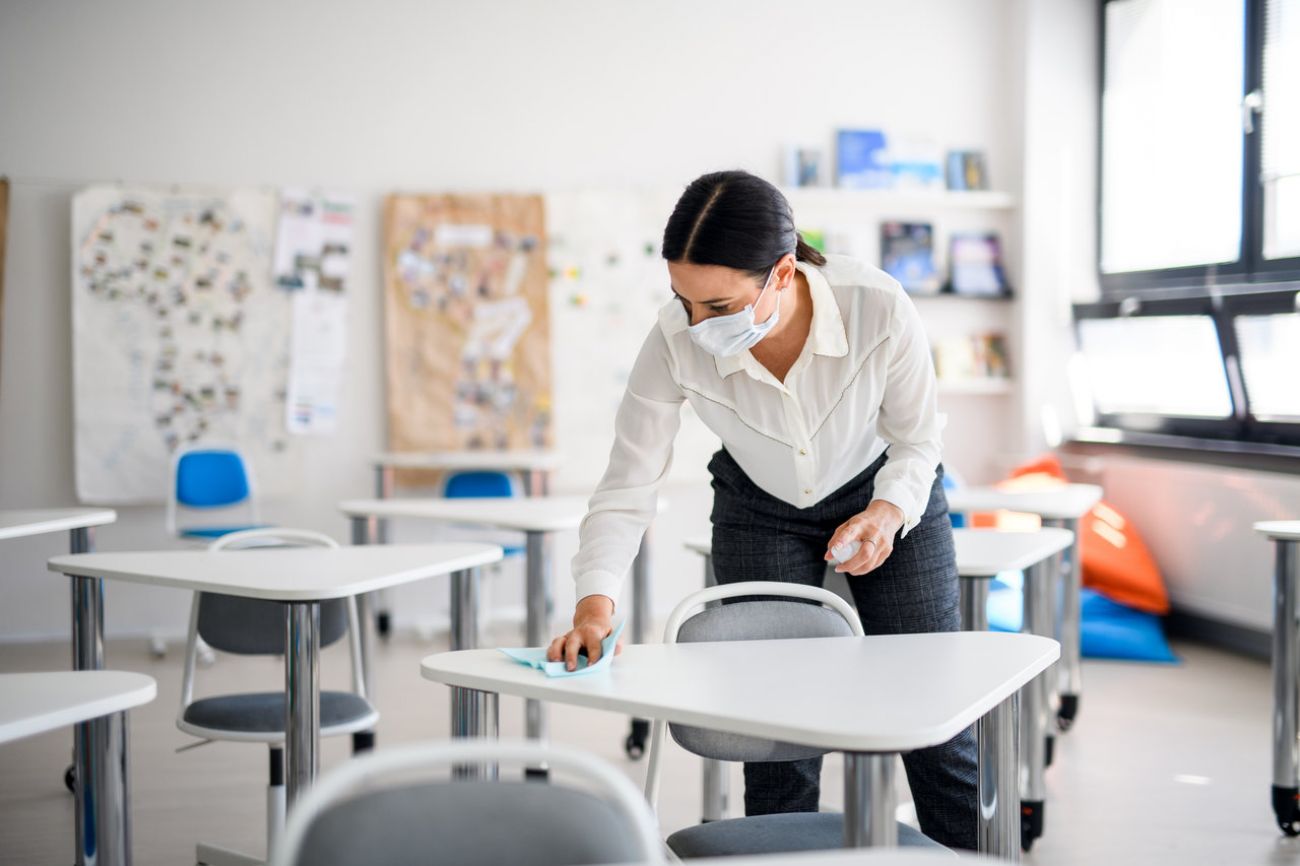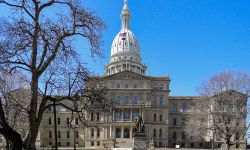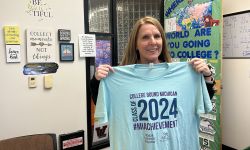Are Michigan schools safe to reopen? Here’s what science and doctors say


School leaders in Grand Rapids, Ann Arbor and Lansing have decided it’s unsafe to bring students back to classrooms. But Senate Majority Leader Mike Shirkey says kids generally don’t get sick from the coronavirus and should return to school.
Gov. Gretchen Whitmer issued an executive order capping attendance at in-door social gatherings at 10 people because of safety concerns. But another executive order has no capacity limit or social distancing requirement for school classrooms.
Confused? You’re not alone.
- Michigan coronavirus unemployment, map, curve, COVID-19 updates
- Dashboard: Michigan coronavirus testing numbers, trends, COVID-19 data
With the start of the school year just weeks away, parents are getting mixed messages about what is safe — and what isn’t — for their children’s education.
One reason is that the coronavirus is a new disease and scientists are still learning about it. For example, in February and March, medical experts said the public didn’t need to wear masks; now, as science has evolved, Michigan and numerous other states require them in public settings.
Another reason: different studies have at times shown different results. The U.S. Food and Drug Administration recently warned against the use of hydroxychloroquine in the treatment of COVID-19, while a study conducted at Henry Ford Health System in Detroit found the drug lowered the death rate among coronavirus patients.
Now, Michigan parents are facing a dizzying mix of messages about school safety. Some districts are planning to return all students to classrooms (with remote learning options for those who aren’t comfortable returning during the pandemic), while sometimes neighboring districts are beginning the school year with fully remote learning, similar to how all Michigan K-12 districts ended the school year this spring.
“There’s so much out there, even I get confused,” said Peter Gulick, an infectious disease expert at Michigan State University.
Here’s where we stand as of the end of July:
What does Michigan require schools to do this fall?
Whitmer’s school reopening plan, developed with the guidance of a 25-member task force of school and health officials, allows schools to make their own decisions about whether they will offer instruction only remotely (through online lessons or printed materials), in person, or a hybrid model. If schools bring students back into classrooms, there are minimum health protocols schools must meet. For instance, in the state’s current pandemic Phase 4, teachers and staff must wear face masks, as well as students in middle and high school.
If the situation improves and the state moves to Phase 5, those requirements become “strong recommendations.” If the state lurches back to Phase 3, all schools close again.
What are schools choosing to do?
Whether your child can attend classes in person or will return to homebound lessons depends on where you live. Two of the state’s largest school districts, Ann Arbor and Grand Rapids, are starting the year online. So are at least five school districts in Ingham County. Many of the school districts in west Michigan’s populous Kent County are returning to classrooms five days a week. Many districts in Oakland County are leaning in that same direction.
Are school-age children at risk of contracting coronavirus?
Children can become infected, but it appears they contract COVID-19 at lower rates than adults.
In Michigan, just 6.6 percent of confirmed coronavirus cases are residents ages 0-19. That’s close to the national average of 7.1 percent of cases among those ages 0-17.
“The data isn’t perfect, but the evidence we do have supports that young kids seem to be less likely to get COVID,” said Dr. Aubree Gordon, associate professor of epidemiology at the University of Michigan.
If my child catches COVID in school, will they get seriously ill?
Probably not. People under the age of 18 who contract the coronavirus generally have either no symptoms or only slight symptoms.
In Michigan, there have been four COVID-related deaths among people ages 0-19, out of 6,191 deaths.
Can kids spread it to others, like school teachers and grandparents?
Yes. A study out of South Korea suggests that children under the age of 10 don’t spread the virus at the same rate as adults. A big caveat: middle- and high-schoolers are just as likely to infect those around them as adults, Gordon said.
And if they spread the virus to adults, those adults are more likely to get seriously ill.
A new study published in the Journal of the American Medical Association says the closing of schools across the country this spring likely saved thousands of lives.
“The young kids aren’t going to get that sick,” said MSU’s Gulick. “The problem is, they take this same virus home to their elders or the poor teacher up front (of the classroom) who may be older or have underlying conditions.
“If we could contain them in the classroom and have them sleep there, there wouldn’t be a problem,” Gulick said.
Why are weddings limited to 10 people for safety, but my child’s classroom can have 30 kids?
The difference, explains U-M’s Gordon, is the age of the people in those gatherings.
“Ten young children is not the same risk as 10 adults,” Gordon said. Children are less likely to get infected, and less likely to get seriously ill if they do catch the virus.
Gordon also suggests that families — and policymakers — weigh the value of public gatherings versus the risk. “Education has a high value,” Gordon said, and a lower COVID risk compared to gatherings of adults.
“Each time you go do anything, you go to the grocery store, even if you wear a mask, there’s some amount of risk and some probability of transmission occurring,” Gordon said. “It’s not just how risky an interaction is, but how vital those interactions are. We all have to get food, that’s vital. But going to a theater or a pool or a wedding, that’s very nice but probably not necessary.”
Homebound learning is safer, but how good is the ‘learning’?
A recent national poll by The Kaiser Family Foundation found that parents were worried about the safety of their children, families and school teachers and staff if schools reopen this fall. But Michigan parents have expressed concerns about whether their children will fall behind academically if they are trying to learn multiplication tables at their kitchen table rather than classrooms.
Michigan families gave mixed reviews to this spring’s pandemic-induced homebound learning, according to a poll of Michigan parents of K-12 students conducted by Public Sector Consultants for Bridge. School leaders have acknowledged that the remote instruction offered in the spring – created on the fly when schools were ordered closed in mid-March – was not as robust as what students would have received in the classroom.
One study suggested that students will return to classrooms in the fall with 70 percent of learning gains in reading that they would typically have had in the previous school year, and less than 50 percent of learning gains in math.
Schools have now had months to strengthen online learning options, in the anticipation that some, if not all, students will be homebound this fall.
An MSU report suggests that students can learn as much through online learning as in-person learning, if online learning allows students to interact with the teacher and other students and allows students to work at their own pace. Other studies comparing academic achievement between online and in-person classes show mixed results.
School leaders acknowledge that remote learning in most cases won’t be as academically rewarding for most students as a normal classroom experience. But they point out that in-person instruction this year will be far from normal, too, with most students wearing face masks, eating lunch at their desks and greatly reduced interaction with classmates.
“A lot of the benefit of in-person schooling is not here,” said Owen Bondono, Michigan’s Teacher of the Year for 2020-21.
My child’s school is reopening. What kind of mask is best?
The masks that offer the most protection are N95 masks, says MSU’s Gulick.
Gordon recommends cloth masks with multiple layers of material.
A key for children: finding masks that fit their faces and are comfortable to wear for hours at a time.
“A mask isn’t going to do any good for your child if they aren’t wearing them because they’re not comfortable wearing them,” Gordon said.
Gordon bought eight different masks for her two elementary-aged daughters to try on, to find ones that they liked and fit on their faces properly. “Make sure it fits well, so they can talk and when they talk it doesn’t come off their nose,” Gordon said.
Here’s a good breakdown of various face masks.
See what new members are saying about why they donated to Bridge Michigan:
- “In order for this information to be accurate and unbiased it must be underwritten by its readers, not by special interests.” - Larry S.
- “Not many other media sources report on the topics Bridge does.” - Susan B.
- “Your journalism is outstanding and rare these days.” - Mark S.
If you want to ensure the future of nonpartisan, nonprofit Michigan journalism, please become a member today. You, too, will be asked why you donated and maybe we'll feature your quote next time!


